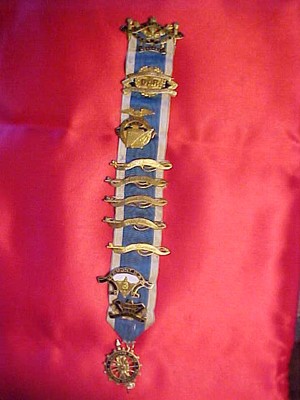I'm tired tonight. Been working too long and hard on genealogy projects that aren't even my own, and for no pay. Who does that?! Me, apparently.
Just after the first of the year, I signed up for the DAR (Daughters of the American Revolution) Genealogical Education Program, or GEP. You have to be a DAR member to take it, which I am, and it comes in three courses. It's self-paced, which means you take it online at your own speed, maybe in the comfort of your jammies. You can take up to 3 months to finish each section, which is plenty of time depending on your schedule, but I want to avoid getting stuck in the details here so let's move on and I'll just say it's super stuff, this GEP course.
Once you complete the course successfully, you get a dandy certificate and the right to purchase your Volunteer Genealogist pin. I even have business cards that say I'm a Volunteer genealogist for the DAR. I just love that! Would you like a card?
It is hoped that you will help women prepare their applications for membership in the DAR. You don't have to, of course. It's totally up to you. But for a true and true genealogist, how could you not help others? I couldn't resist!! And listen to this: you get to find out about other people's ancestors! I've helped women with a wide variety of skills when it comes to genealogy, from total beginners with no tree to some very savvy ladies with mad skills. I learn something from all of them.
So here are five tips I've picked up from doing this work. There are probably at least a 100! They may seem obvious and you could probably make this list yourself, but for me, let me just mention that some lessons are learned the hard way.
Top Tip: Get over the crazy on your tree!
Everyone has a bit of crazy on their tree. When you look at a lot of trees and get to know the ancestors on every branch, you'll find some crazy going on here and there. From high crimes and treason to garden variety desertion - which has to be the most frequent every-day brand of crazy - everyone finds some on their tree, if they look. If you think your ancestors are perfect and saintly, well, you're probably not looking deep enough into their lives. Perfection is not a natural human state. "We weren't there and we can't know what happened, so we shouldn't judge." Repeat often! Then you'll be ready for whatever crazy you find.
The thing about crazy, if you're not ready for it and haven't taken time to consider how you might feel about it, is that it saps energy out of your pursuit. It can throw you off track. And if you find it personally embarrassing you might consciously or subconsciously be inclined to ignore it, shove it aside and not see that the child was adopted, lent out for work, and the mother not married. Look at the years. Do they make sense? Was the dad over 80 when the child was born. Not impossible. But how old was the mother? 50? Not going to happen. Now go look at the neighbor men. And don't be embarrassed. It has nothing to do with you.
On the other hand, if you embrace the crazy, it could take you to some place you've never been and give greater insight into family dynamics!
Look at every part of every document.
Imagine this. You pick up that death certificate of your great grandfather and pick out the date and place of death. And then move on to the next document. Right? Oh, no!
Instead, take time with that death certificate and examine it closely. Time with a document will make you a better genealogist, no doubt about it. If you just make one improvement to the way you work, take time to examine each document very closely, and in its entirety.
Much has been written about the value of death certificates to the family history enthusiast, so I won't cover that well-worn ground here. But I will say that a technique I use is to works in two steps. First, scan the document for relevant info to the problem at hand. What year did he die? Where was he born? What was his mother's maiden name? Find that and satisfy the reason you went looking for the document in the first place. In that way, you'll feel better about the search because you either found what you were looking for or didn't.
Then take five minutes or longer and let your eyes scan the entire document top to bottom, looking at every line filled in and every blank space. What does it say? And then what does it mean?
When that's done, take more time and thing about the time and place where the document was made. Give it some context. Was there a doctor in the town where they lived? Did they live way out in the country? In a city? How might that change the data you see there?
And here's a big tip for a death certificate: who exactly was the informant? Take a moment now and think about how the identity of the informant might influence the data on the death certificate.
Network with others especially the family genealogists or historians whose names you run into.
If you see a name on Find A Grave as the one who runs the memorial page, contact that person. If you see a flower or photo there, especially if the surname is the same as the deceased or the relationship is spelled out, get in contact!
I've learned so much from connections made there, on Ancestry, and on the message boards! Documents, both rare and common, have been shared willingly. Recently, I received a privately published history of a family line from a researcher who is a retired history professor. Footnotes!! He had it in his DropBox account and sent me an invite so that I could go get it and download a copy. How cool is that? And a bunch of sources on every page!
When looking at Ancestry trees you can tell if an ancestor page is fully built out with lovely documents or if it is very sketchy. If it looks fully packed, you can just bet that there's more to be had, with a polite introduction and kind words:)
Discipline!
I have two thoughts here. The first is that you really do need a goal for the task at hand. When you sit down at the computer, know what you're doing and where you'll go to hunt for what you're looking for. Yes, it makes sense and yes, I do know how hard it is not to run after that next shiny object that catches your eye. But if you have a goal for the task at hand and also keep a list of your shiny objects to get back to later, you'll be more likely to get where you need to go.
The only way you'll make progress is by keeping on track and carefully working back up your tree.
And for gosh sakes, keep a log. Just open a Word document or make a Evernote file and store URLs and comments there. About the fifth time you cover research ground you've covered before, you'll get this!!
Connecting generations.
This is the one thing I emphasize to prospective members: it's not enough to find that birth, death, and marriage information in citable sources, you have to connect those generations. And this can be the most difficult aspect of our work but without those connections all we really have is a file of individuals who aren't connected. Not a tree but a box full of leaves.
The famed 1850 census is the point of departure and before that and going back in time, it becomes increasingly more difficult to find a document that connects father to son. Harder still is connecting mother to daughter, or just finding a maiden name!
Of course, as you've probably seen, it greatly depends on what part of the country your ancestors inhabited. If they hailed from a urban area in one of the 13 original colonies, you might stand a chance. If they came from Plymouth, you can be optimistic about your search. But if they were on the frontier where folks were born at home and died there too and were buried in a family farm cemetery with just an wooden cross, and no bible at home... good luck to you. Hope that she kept a diary, but then she probably didn't read or write. If so, what use was a bible? And you'll notice that documents were signed with an "X".
True confessions: for me, the most difficult generational connection to document has been the grandchild of the patriot to his or her parent, the child of the patriot. The grandchildren were most likely born about 1800 to 1820. Their grandparents left all manner of records and a nice will and fat probate packet because they usually did well in life and they couldn't wait to own land. Some were even given land for their service.
The child of the patriot often didn't leave a will even though they too were prosperous and landed. Maybe they thought they didn't need it. Maybe they took care of affairs before passing, gave land to children, mostly male, and he and his wife went to live with one of the children. That's all I can say about that because I truly do not understand why the lack of document trail happens with this generation. If you have any thoughts, I'd like to hear them please.
Sad to say but sometimes we just don't get to find that elusive connection. We just don't find all of the documents we'd like to have. Guess that has to be my last tip.
The URL for this post is:
http://nutsfromthefamilytree.blogspot.com/2015/11/five-tips-ive-learned-by-working-as-dar.html




























%2BDAR%2Bdatabase.png)
%2BDAR%2BFB.png)
